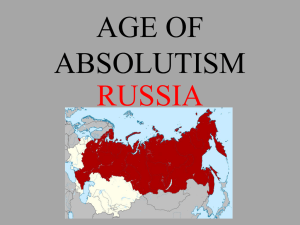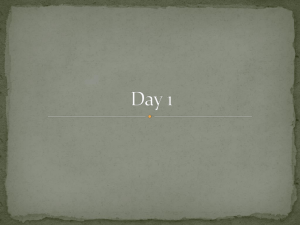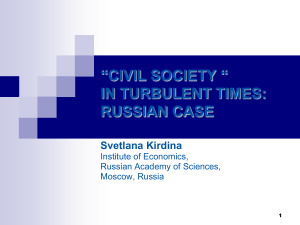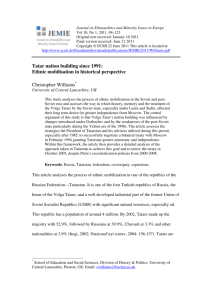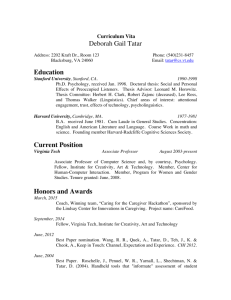File - AP World History
advertisement
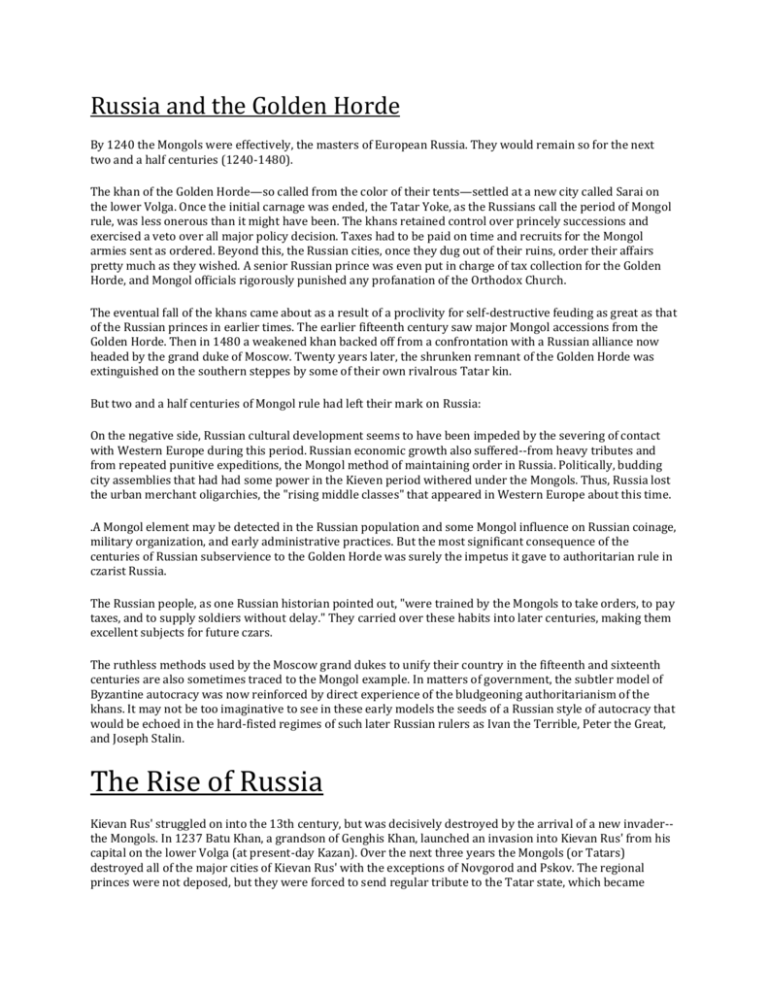
Russia and the Golden Horde By 1240 the Mongols were effectively, the masters of European Russia. They would remain so for the next two and a half centuries (1240-1480). The khan of the Golden Horde—so called from the color of their tents—settled at a new city called Sarai on the lower Volga. Once the initial carnage was ended, the Tatar Yoke, as the Russians call the period of Mongol rule, was less onerous than it might have been. The khans retained control over princely successions and exercised a veto over all major policy decision. Taxes had to be paid on time and recruits for the Mongol armies sent as ordered. Beyond this, the Russian cities, once they dug out of their ruins, order their affairs pretty much as they wished. A senior Russian prince was even put in charge of tax collection for the Golden Horde, and Mongol officials rigorously punished any profanation of the Orthodox Church. The eventual fall of the khans came about as a result of a proclivity for self-destructive feuding as great as that of the Russian princes in earlier times. The earlier fifteenth century saw major Mongol accessions from the Golden Horde. Then in 1480 a weakened khan backed off from a confrontation with a Russian alliance now headed by the grand duke of Moscow. Twenty years later, the shrunken remnant of the Golden Horde was extinguished on the southern steppes by some of their own rivalrous Tatar kin. But two and a half centuries of Mongol rule had left their mark on Russia: On the negative side, Russian cultural development seems to have been impeded by the severing of contact with Western Europe during this period. Russian economic growth also suffered--from heavy tributes and from repeated punitive expeditions, the Mongol method of maintaining order in Russia. Politically, budding city assemblies that had had some power in the Kieven period withered under the Mongols. Thus, Russia lost the urban merchant oligarchies, the "rising middle classes" that appeared in Western Europe about this time. .A Mongol element may be detected in the Russian population and some Mongol influence on Russian coinage, military organization, and early administrative practices. But the most significant consequence of the centuries of Russian subservience to the Golden Horde was surely the impetus it gave to authoritarian rule in czarist Russia. The Russian people, as one Russian historian pointed out, "were trained by the Mongols to take orders, to pay taxes, and to supply soldiers without delay." They carried over these habits into later centuries, making them excellent subjects for future czars. The ruthless methods used by the Moscow grand dukes to unify their country in the fifteenth and sixteenth centuries are also sometimes traced to the Mongol example. In matters of government, the subtler model of Byzantine autocracy was now reinforced by direct experience of the bludgeoning authoritarianism of the khans. It may not be too imaginative to see in these early models the seeds of a Russian style of autocracy that would be echoed in the hard-fisted regimes of such later Russian rulers as Ivan the Terrible, Peter the Great, and Joseph Stalin. The Rise of Russia Kievan Rus' struggled on into the 13th century, but was decisively destroyed by the arrival of a new invader-the Mongols. In 1237 Batu Khan, a grandson of Genghis Khan, launched an invasion into Kievan Rus' from his capital on the lower Volga (at present-day Kazan). Over the next three years the Mongols (or Tatars) destroyed all of the major cities of Kievan Rus' with the exceptions of Novgorod and Pskov. The regional princes were not deposed, but they were forced to send regular tribute to the Tatar state, which became known as the Empire of the Golden Horde. Invasions of Russia were attempted during this period from the west as well, first by the Swedes (1240) and then by the Livonian Brothers of the Sword (1242), a regional branch of the fearsome Teutonic Knights. In the best news of the era for Russia, both were decisively defeated by the great warrior Alexander Nevsky, a prince of Novgorod who earned his surname from his victory over the Swedes on the Neva River. For the next century or so, very little seems to have happened in Russia. In fact, given the tribute demanded by the Tatars, there wasn't much money available for building, campaigns, or anything else of that sort. With the Tatars off to the southwest, the northeastern cities gradually gained more influence--first Tver, and then, around the turn of the 14th century, Moscow. As a sign of the city's importance, the patriarch of the Russian Orthodox Church was transferred to the city, making it the spiritual capital of Russia. By the latter part of the century, Moscow felt strong enough to challenge the Tatars directly, and in 1380 a Muscovite prince named Dmitri Donskoy had the audacity to attack them. His decisive victory at Kulikovo Field immediately made him a popular hero, though the Tatar retaliation two years later maintained their rule over the city. It wasn't until 1480, after another century had passed, that Moscow was strong enough to throw off Tatar rule for good. Its ruler at that time was Grand Duke Ivan III, better known as Ivan the Great. Ivan began by subjugating most of Moscow's rival cities, and by the time he tore up the charter binding it to Tatar tribute he was effectively in control of the entire country. However, it wasn't until the reign of his grandson, Ivan IV (the Terrible), that Russia became a unified state. Ivan the Terrible succeeded his father Vasily III as Grand Duke of Moscow in 1533 at the age of three. His mother served as regent until she too died, when Ivan was eight. For the next eight years, the young Grand Duke endured a series of regents chosen from among the boyars (the nobility). Finally in 1547, he adopted the title of tsar and set about crushing the power of the boyars, reorganizing the military, and preparing to smite the Tatars. In 1552 he conquered and sacked Kazan, and in 1556 Astrakhan, having thus destroyed the lingering power of the Golden Horde. Ivan's Tatar campaigns opened vast new areas for Russian expansion, and it was during his reign that the conquest and colonization of Siberia began. Believe it or not, Ivan was not supposed to have been very terrible at all during the early years of his reign. However, as he grew older his temper worsened, and by the 1560s he carried out a pretty horrific campaign against the boyars, confiscating their land and executing or exiling those who displeased him. In 1581, in a rage, he struck his son and heir Ivan with an iron rod, killing him. When Ivan the Terrible died in 1584, he was succeeded by his son Fyodor, who was not exactly up to filling the shoes of an autocratic legend. Fyodor left most of the management of the kingdom to his brother-in-law, Boris Godunov, and it was not long before Godunov began to work to secure the succession for himself. In 1591, he murdered Fyodor's younger brother Dmitri in the ancient town of Uglich, a spot now marked by the magnificent Church of St. Demetrius on the Blood. When Fyodor died in 1598, Godunov was made tsar, but his rule was never accepted as entirely legitimate. Within a few years a pretender arose in Poland, claiming to be Dmitri, and in 1604 he invaded Russia. Godunov died suddenly the next year, and the "Time of Troubles" began. For the next eight years both the first and a second false Dmitri laid claims to the throne, both supported by invading Polish armies. Finally, in 1613, the Poles were ousted from Moscow, and the boyars unanimously elected Michael Romanov as Tsar. The Romanov dynasty was to rule Russia for the next 304 years, until the Russian Revolution brought an end to the Tsarist state.
